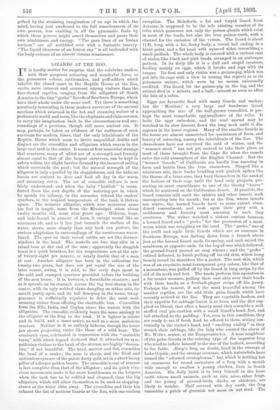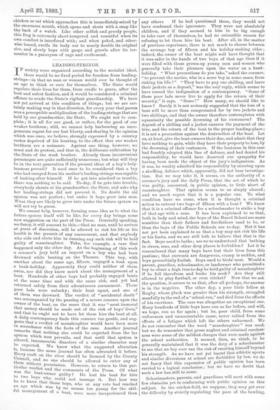LIZARDS AT THE ZOO.
IT is hardly matter for surprise that the colubrine snakes, with their gorgeous colouring and wonderful form, or the poisonous cobras, rattlesnakes, and puff-adders which inhabit the closed cases in the Reptile House at the Zoo, excite more interest and comment among visitors than the four-footed reptiles, ranging from the alligators of South America to the tiny "gecko" lizards of Southern Europe, which have their abode under the same roof. Yet there is something peculiarly interesting in these modern survivors of the ancient saurians which swarmed in the hot and steaming waters of a prehistoric world, and seem, like the elephants and rhinoceroses, to carry the imagination back to the circumstances and sur- roundings of a previous, though still more ancient era. It may, perhaps, be taken as evidence of the unfitness of such survivals for modern times, that the only inhabitants of the Reptile House which seem to invite unqualified dislike and disgust are the crocodiles and alligators which swarm in the large oval tank in the centre. It seems at first somewhat strange that creatures, many of which are of a strength and ferocity almost equal to that of the largest carnivore, can be kept in safety within the slight barrier formed by the incurved railing which surrounds the pool ; but the natural strength of the alligator is only equalled by its sluggishness, and the hideous beasts are content to doze and feed all day in the warm and steaming water. The art of crocodile culture is now fairly understood, and when the baby " basilisk " is trans- ferred from the cool depths of the watering-pot in which he spends his infancy, in the nurseries behind the snakes' quarters, to the tropical temperature of the tank, it thrives apace. The monster alligator, which now measures some ten feet in length, came from the Mississippi when about twelve months old, some nine years ago. Hideous, huge, and hide-bound in armour of horn, it swings round like an enormous eft, and as it lies just beneath the surface of the water, shows, more clearly than any book can picture, the curious adaptation to surroundings of the carnivorous water- lizard. The eyes on their raised orbits are set like dormer- windows in the head. The nostrils are two tiny slits in a raised boss at the end of the nose ; apparently the sluggish beast is a quick breather, for the respirations are at the rate of twenty-eight per minute, or nearly double that of a man at rest. Another alligator has been in the collection for twenty-two years, but does not yet equal the size of the later corner, owing, it is said, to the early days spent in the cold and cramped quarters provided before the building of the new house. It is, however, a formidable creature; and as it sprawls on its stomach across the big tree-stump in the centre, with its ugly webbed claws dangling on either side, its mouth partly open, and its tail drooping in the water, its ap- pearance is sufficiently repulsive to deter the most well- meaning visitor from offering the charitable bun. Crocodiles from the Nile, India, and Ceylon share the waters with the alligators. The crocodile evidently bears the same analogy to the alligator as the frog to the toad. It is lighter in colour and in build, and a more active, as well as a more malicious creature. Neither is it so entirely hideous, though the lower jaw shows projecting tusks like those of a wild boar. The creature's eyes, celebrated in connection with the "crocodile tears," with which legend declared that it attracted its sym- pathising victims to the bank of the stream, are highly "decora- tive," if not beautiful. The head, narrow and flat, resembles the head of a snake ; the nose is sharp, and the fixed and motionless eyes are of the palest dusty gold, set in a short horny pillar of a deeper golden brown. The crocodile's coat of armour is less complete than that of the alligator; and its quick viva- cious movements make it far more troublesome to the keepers when the tank has to be refilled and cleansed, than the big alligators, which will allow themselves to be used as stepping- stones as the water ebbs away. The crocodiles and their kin exhaust the list of noxious lizards at the Zoo, with one curious
exception. The Heloderin, a fat and torpid lizard from Arizona, is supposed to be the sole existing member of its tribe which possesses not only the poison-glands which exist in most of the toads, but also the true poison-teeth, with a channel for the emission of the venom. The lizard is about li ft. long, with a fat, fleshy body, a round tail ending in a blunt point, and a flat head with squared sides, resembling a small padlock. The whole body is covered with a curious coat of scales, like black and pink beads, arranged in an arabesque pattern. In its daily life it is a dull and stupid creature, feeding mainly on eggs, which it breaks and laps with its tongue. Its first and only victim was a guinea-pig, which was put into its cage with a view to testing the reports as to its poisonous nature, which were by no means universally credited. The lizard bit the guinea-pig in the leg, and the animal died in a minute and a half,—almost as soon as after the bite of a cobra.
Eggs are favourite food with many lizards and snakes; but the Monitor,' a. very large and handsome lizard approaching the size of the half-grown crocodiles, is per- haps the most remarkable egg-swallower of the tribe. It bolts the eggs unbroken, and the oval morsel may be watched in its slow descent down the long neck until it dis- appears in the lower regions. Many of the smaller lizards in the house are almost unmatched for quaintness of form, and beauty of colouring, among the inhabitants of the Zoo. The chameleons have not survived the cold of winter, and the "summer stock" has not yet arrived to take their place, as most of those brought from the Cape die when the vessels enter the cold atmosphere of the English Channel. But the "horned lizards" of California are hardly less amusing in form and habits than the true chameleon. Shaped like a miniature sole, their backs bristling with pinkish spikes like the thorns of a briar-rose, they bury themselves in the sand at the bottom of their cage until the head only projects, pre- senting an exact resemblance to one of the thorny " burrs " which lie scattered on the Californian desert. If possible, the lizard remains still until the spiders and other insects walk unsuspecting into its mouth; but at the Zoo, where insects are scarce, the horned lizards have to some extent aban- doned concealment, and rush upon their prey with a suddenness and ferocity most amusing in such tiny creatures. The writer watched a violent contest between a horned lizard and a " gecko " for the possession of a meal- worm which was wriggling on the sand. The "gecko," one of the swift and agile little lizards which are so common in Southern Europe, was darting down from a branch above just as the horned lizard made its spring, and each seized the mealworm at opposite ends. In the tug-of-war which followed, the ground-lizard proved an easy winner; and the " gecko " retired defeated, to finish pulling off its old skin, which hung loosely round its shoulders like a jacket. The cast skin, which was of an exquisite, semi-transparent grey colour, like that of a moonstone, was pulled off by the lizard in long strips, by the aid of its teeth and feet. The toads perform this operation in a far neater manner, pulling their cast skin over their heads with their hands, as a football-player strips off his jersey. Perhaps the tamest, if not the most beautiful among the smaller reptiles, are the odd little palm-lizards which have recently arrived at the Zoo. They are vegetable feeders, and their appetite for cabbage-leaves is so keen, and the diet sup- plied so liberal, that after a hearty meal they resemble a well- staffed oval pin-cushion with a small lizard's head, feet, and tail attached to the padding. Yet, even in this condition, they are ready to eat if fresh food be offered to them, sitting con- tentedly in the visitor's hand, and "swelling visibly" as they munch their cabbage, like the lady who excited the alarm of Mr. Weller, senior, at the Temperance tea. A near neighbour of the palm-lizards is the existing type of the impostor frog who tried to inflate himself to the size of the bullock, according to the fable. Esop's frog, no doubt, lived in the swamps of Lake Copais ; and the strange creature, which naturalists have named the "adorned ceratophorus," but which is nothing but an enormous fat round caricature of a frog, with a mouth wide enough to swallow a young chicken, lives in South America. His daily habit is to bury himself in the loose earth where small animals, such as rats, mice, other frogs, and the young of ground-birds, ducks or chickens, are likely to wander. Half covered with dry earth, the frog resembles a patch of greenish wet moss on wet mud. The
ohicken or rat which approaches this is immediately seized by the enormous mouth, which opens and shuts with a snap like the back of a watch. Like other selfish and greedy people, This frog is extremely short-tempered and resentful when its own comfort is interfered with; and when poked, and other- wise teased, swells its body out to nearly double its original size, and slowly hops with gasps and growls after its tor- mentor in a paroxysm of rage and excitement.







































 Previous page
Previous page